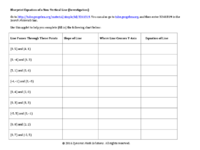
Slope Illustrator
Move the two points around to change the slope of the line. Note how the slope changes as you do.
Blueprint Equation of a Line (I)
[color=#000000]This applet accompanies the [/color][i][color=#0000ff][b]Blueprint Equation of a Line[/b] [/color][/i][i][color=#0000ff]lesson activity[/color][/i][color=#000000] given to you in class. [br]Please use this applet to help you complete this activity.[br]If, at any time, you need to reference the [/color][i][color=#0000ff]Slope: Intuitive Introduction [/color][/i][color=#000000]applet, it can be found [/color][url=https://tube.geogebra.org/m/Xutr9rPj]here[/url][color=#000000]. [br][br][/color][color=#000000][b]Teachers:[/b] [/color][color=#cc0000][b]A pdf copy of this[/b] [/color][color=#0000ff][b]lesson activity [/b][/color][color=#cc0000][b]can be found below this applet.[/b][/color]
Blueprint Equation of a Nonvertical Line (Investigation)
Writing the Equation of a Line (I-VA)
[color=#cc0000][b]Teachers:[/b][/color][br][br]This applet generates examples where the y-intercept is an integer. The purpose of this applet is to formatively test students' knowledge of writing the equation of a line by mere observation. [br][br][color=#cc0000][b]Students:[/b][/color][br][br]For the line displayed, write the slope-intercept form of its equation in the input box below. [br][color=#3c78d8][b]For some problems, you may need to ZOOM OUT in order to see the black point on the line. [/b][/color][br][color=#ff00ff][b]If you enter this equation correctly, you'll see a big "CORRECT"! text appear. [/b][/color] [br][br][color=#0000ff][i]Repeat this exercise as many times as you need in order to master this concept! [/i][/color]
Is P(x, y) a Solution?
Drag the point to various positions (both ON and OFF the line). Pay attention to what you see here. Then, answer the questions that follow.
If a point [math]\left(x,y\right)[/math] LIES on a line with a given equation, what can we conclude?
If a point [math]\left(x,y\right)[/math] DOES NOT LIE on a line with a given equation, what can we conclude?
If we wanted to see whether [math]\left(4,-3\right)[/math] was a solution to the equation [math]3x-5y=27[/math], what would we need to do first?
Is [math]\left(4,-3\right)[/math] a solution to the equation [math]3x-5y=27[/math]?
If we wanted to see whether [math]\left(-3,4\right)[/math] was a solution to the equation [math]3x-5y=-30[/math], what would we need to do first?
Is [math]\left(-3,4\right)[/math] a solution to the equation [math]3x-5y=-30[/math]?
Solving Linear Systems Algebraically: Quiz (V1)
[b]Directions:[/b][br][br]On a separate sheet of paper, solve the system of linear equations shown in the upper right hand corner of the applet. Once you obtain your solution, move the BIG WHITE POINT (shown in the coordinate plane on the left) to the location of the solution of this system. [br][br][color=#ff7700][b]If you solve this system correctly, the applet will automatically notify you. [/b][/color][br][br][color=#0000ff][i]Generate as many practice problems as you need in order to master this concept! [/i][/color]
Basic Quadratic Function (I)
[color=#000000]Interact with the applet below for a minute. [br]Then, answer the question that follows. [/color]
[color=#000000]How does the parameter "a" affect the graph of this quadratic function? [br]Explain. [/color]
Multiplying Binomials
In the following applet, you will use algebra tiles to multiply 2 binomials.
1) What is the formula for the area of a rectangle? [br]2) If a farmer partitioned his/her field into 4 separate regions, how could he/she find the area of this field? (Explain 2 methods of calculating the total area.)
Locus Problem (1)
In the applet below, [br][br][i][color=#1e84cc][b]F[/b][/color][/i][color=#1e84cc][b] is a point[/b] [/color]that is not on line [i]d[/i]. [br][b]Point [i]D[/i] is a point that lies ON [color=#666666]the line that passes through [i]A [/i]and [i]B[/i][/color]. [br][/b]The [color=#ff00ff][b]pink line[/b][/color] is the [color=#ff00ff][b]perpendicular bisector[/b][/color] of the segment with endpoints [i][color=#1e84cc][b]F[/b][/color][/i] and [i][b]D[/b][/i]. [br][br]Drag [b]point [i]D[/i][/b] along the line. What do you see? Describe in detail! [br] [br]Feel free to alter the locations of [color=#666666][i][b]A,[/b][/i][/color] [i][color=#666666][b]B[/b][/color], [/i]and/or [i][color=#1e84cc][b]F[/b][/color][/i][color=#666666]. [br][/color]Then [color=#38761d][b]clear the trace[/b][/color] and drag [b]point [i]D[/i][/b] along [color=#666666][b]the line[/b][/color] again. [br][br]Why does this occur?
Please go to the [url=https://www.geogebra.org/m/sduBXC6P]Locus Construction 1 Task[/url] and begin!
